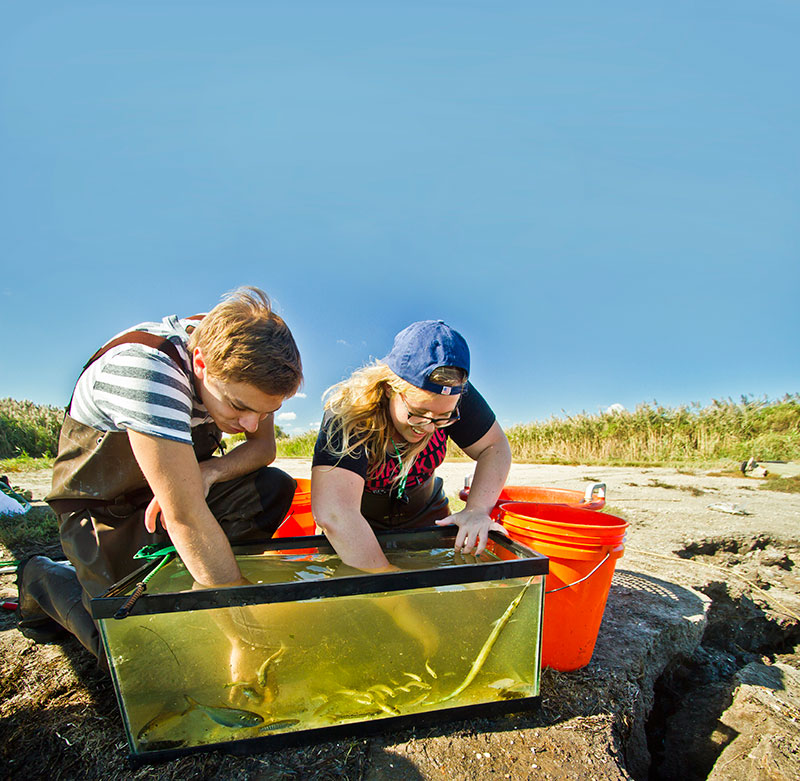Anytime you start something new, it’s important to have a good motto. This mission, this baseline, is the driving force behind all that you do. For the faculty and leadership in Drexel’s new Biodiversity, Earth and Environmental Science (BEES) Department—a department made possible by the University’s merger with the Academy of Natural Sciences last year—the motto “Field Experience, Early and Often” was an easy choice. After all, work in the field is crucial in the natural sciences, particularly environmental science, and getting these students out of the classroom and into the very environment they study is experiential learning at its best.
It was decided early on in the development of the new department that a pre-term field experience would be offered to incoming freshmen and sophomores, as such opportunities were not available prior to the affiliation with the Academy, and the program wasted no time enacting the “early” portion of the motto. In fact, this September, just days before classes even began, three incoming freshman and seven sophomores were introduced to current field methods used by environmental scientists, worked side-by-side with their soon-to-be professors, and made new friends along the way.
The students spent two nights and three days at the Barnegat Bay Field Station at the Lighthouse Center for Natural Resource Education in Ocean Township, NJ. The facility is owned by the New Jersey Department of Environmental Protection’s Division of Fish and Wildlife and is situated on 194 acres of land with a wide range of habitats available for education and research including a maritime forest, salt marsh, tidal streams and a freshwater impoundment.
BEES faculty and staff led a series of field trips to explore a variety of coastal, marsh and terrestrial habitats. The students were exposed to many of the state-of-the-art environmental monitoring techniques and collection methods used by BEES faculty. Freshman Kerry Rugenstein said it best—“In the first 48 hours of college, I was knee-deep in mud. I don’t think any of my friends
at other schools can say that.”
The Barnegat Bay trip is certainly not the last time the students will be getting their hands dirty. To satisfy the “often” portion of the BEES motto, four of the five core courses in the curriculum have an intensive fieldwork component. For many of the incoming students, though, the pre-term field experience was an unforgettable first.
“I never thought I’d ever be able to go into the ocean, or the bay in this respect, and literally pick up the marine life,” said freshman Jackie Garcia. “I just didn’t imagine having that kind of experience.”
After trying out a few different activities, sophomore Zak Cirelli realized that his interests lie in fisheries. “I love fishing, so this is right up my alley,” Cirelli said while winding up a seine net. “[Fisheries scientists] spend half their time examining the fish they caught during the other half.”
During the Barnegat Bay experience, the idea was to have a little fun, too.
“On Saturday, we set up some crab traps and those ended up being pretty fruitful,” Cirelli said. “So, we cooked them and we had a pretty good dinner of seafood and burgers.”
“We didn’t want to go into a great amount of detail and we didn’t want to lecture,” said Dr. Tracy Quirk, a wetlands ecologist at the Academy and a BEES faculty member, about the purpose of the field experience. “It’s about getting the students out there and becoming familiar with some of the tools of the trade.”
The students noted that the field experience also provided a unique opportunity to get to know their professors in a non-traditional way.
“When we were driving here, we heard what the professors are doing—they’re working in places like Chile and Mongolia,” said sophomore Alex Leszczynski. “It’s awesome. It gives us an idea of what we can get into and where this will take us.”
The students also recognized that it was a chance to bond with their peers, as well.
“This is meant to be a bonding experience for the students,” said Dr. David Velinsky, director of the Academy’s Patrick Center for Environmental Research and head of the new department. “We wanted to get the small number of BEES students together to build a cohort and a sense of identity.”
Undergrads in the department (there are 47 students total) must take five core courses, Velinsky said, and from there, they choose a concentration, in fields including Biodiversity and Evolution, Earth Science, and Ecology and Conservation.
“By the end of their second year, these students should have a really good idea of what this department is all about,” Velinsky said.
“In the first 48 hours of college, I was knee-deep in mud. I don’t think any of my friends at other schools can say that.”
To learn more about the BEES department or its faculty, visit www.drexel.edu/bees.



